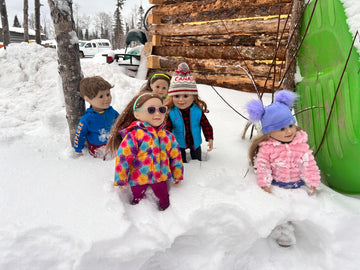Over two years of extensive research went into the creation of Saila, the Maplelea Girl who shares her Inuit heritage. In our quest to create a character who would be an accurate reflection of a 10 year old girl growing up in Iqaluit today, we sought out many sources of information.

We participated in the 10th anniversary celebration for the creation of the territory of Nunavut held in Ottawa, attended an Inuit Awareness seminar, consulted with numerous resource people, and read on-line and printed material extensively. Then, president Kathryn Gallagher Morton and her family travelled to Iqaluit where they spent ten days getting to know the city and its people. They sampled traditional country foods, participated in the Christmas Games, stayed in a local home, watched a stone carver at work, talked to craftspeople at a local craft show, attended a bilingual church service (English and Inuktitut), visited a school and other community facilities and agencies, toured the parliament buildings and chatted with a lot of very friendly people.
Kathryn sought out local Maplelea families and asked them for their ideas and suggestions for this new character. While attending the Christmas Games held at a local hall over several evenings, Kathryn had the opportunity to personally interview a number of girls who eagerly shared with her their stories of what it is like to be a young girl growing up in Nunavut today.
 We commissioned our Canadian artist to sculpt the new doll and, based on the information we had gathered, created a wardrobe and accessories for her. The journal was written and illustrated and then translated into French and Inuktitut.
We commissioned our Canadian artist to sculpt the new doll and, based on the information we had gathered, created a wardrobe and accessories for her. The journal was written and illustrated and then translated into French and Inuktitut.
We sought out production facilities in Nunavut and were thrilled to contract with Uqqurmiut Centre for Arts and Crafts in Pangnirtung to produce a Pang hat for Saila, and also with Kiluk Ltd. in Arviat to produce an amauti for her.

We wanted Saila to be an interesting, authentic and positive role model, not just for girls of Inuit heritage living in Nunavut, but for all girls living in all parts of Canada. We think we have achieved that. We hope you agree.
We would like to thank all the girls, families and community members of Nunavut who so openly and kindly shared their stories and experiences, only a few of which are shown here. The information was extremely helpful in the creation of our Saila Qilavvaq character.






Saila was one of a number of traditional Inuit names that were suggested to us while we were researching the project.
How did Saila get her name?